
Casimir III the Great reigned as the King of Poland from 1333 to 1370. He also later became King of Ruthenia in 1340, and fought to retain the title in the Galicia-Volhynia Wars. He was the last Polish king from the Piast dynasty.

Géza, also Gejza, was Grand Prince of the Hungarians from the early 970s. He was the son of Grand Prince Taksony and his Oriental—Khazar, Pecheneg or Volga Bulgarian—wife. He married Sarolt, a daughter of an Eastern Orthodox Hungarian chieftain. After ascending the throne, Géza made peace with the Holy Roman Empire. Within Hungary, he consolidated his authority with extreme cruelty, according to the unanimous narration of nearly contemporaneous sources. He was the first Hungarian monarch to support Christian missionaries from Western Europe. Although he was baptised, his Christian faith remained shallow and he continued to perform acts of pagan worship. He was succeeded by his son Stephen, who was crowned the first King of Hungary in 1000 or 1001.

Jadwiga, also known as Hedwig, was the first woman to be crowned as monarch of the Kingdom of Poland. She reigned from 16 October 1384 until her death. She was the youngest daughter of Louis the Great, King of Hungary and Poland, and his wife, Elizabeth of Bosnia. Jadwiga was a member of the Capetian House of Anjou, but she had more close forebears among the Polish Piasts than among the Angevins.

Mary, also known as Maria of Anjou, reigned as Queen of Hungary and Croatia between 1382 and 1385, and from 1386 until her death. She was the daughter of Louis the Great, King of Hungary and Poland, and his wife, Elizabeth of Bosnia. Mary's marriage to Sigismund of Luxembourg, a member of the imperial Luxembourg dynasty, was already decided before her first birthday. A delegation of Polish prelates and lords confirmed her right to succeed her father in Poland in 1379.

Louis I, also Louis the Great or Louis the Hungarian, was King of Hungary and Croatia from 1342 and King of Poland from 1370. He was the first child of Charles I of Hungary and his wife, Elizabeth of Poland, to survive infancy. A 1338 treaty between his father and Casimir III of Poland, Louis's maternal uncle, confirmed Louis's right to inherit the Kingdom of Poland if his uncle died without a son. In exchange, Louis was obliged to assist his uncle to reoccupy the lands that Poland had lost in previous decades. He bore the title of Duke of Transylvania between 1339 and 1342 but did not administer the province.
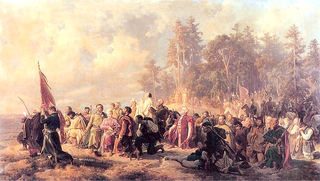
The Bar Confederation was an association of Polish–Lithuanian nobles (szlachta) formed at the fortress of Bar in Podolia, in 1768 to defend the internal and external independence of the Polish–Lithuanian Commonwealth against Russian political influence and against King Stanislaus II Augustus with Polish reformers, who were attempting to limit the power of the Commonwealth's wealthy magnates.

In a strict sense, the Union of Krewo or Act of Krėva comprised a set of prenuptial promises made at Kreva Castle on 14 August 1385 by Jogaila, Grand Duke of Lithuania, in regard to his prospective marriage to the underage reigning Queen Jadwiga of Poland.
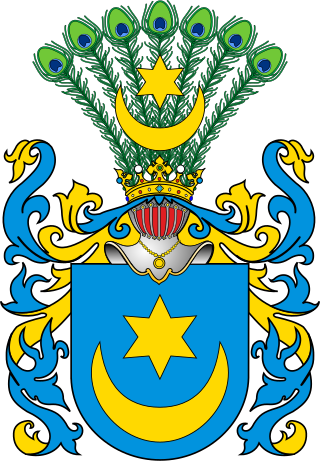
The House of Tarnowski is the name of a Polish noble and aristocratic family. Because Polish adjectives have different forms for the genders, Tarnowska is the form for a female family member.

Spytek of Melsztyn was a Polish nobleman (szlachcic) of the Leliwa coat of arms.

Spytek of Melsztyn, also known as Spytko, was a member of the Polish nobility and a strong supporter of Polish cooperation with the Hussite movement.

Elizabeth of Bosnia was queen consort of Hungary and Croatia, as well as queen consort of Poland, and, after becoming widowed, the regent of Hungary and Croatia between 1382 and 1385 and in 1386.

Elizabeth of Austria was Queen of Poland by marriage. She was the eldest of fifteen children of Ferdinand I, Holy Roman Emperor, and his wife Anne of Bohemia and Hungary. A member of the House of Habsburg, she was married to Sigismund II Augustus, who was already crowned as King of Poland and Grand Duke of Lithuania even though both of his parents were still alive and well. The marriage was short and unhappy. Elizabeth was of frail health, experiencing epileptic seizures, and died at age 18.

Elizabeth of Pomerania was the fourth and last wife of Charles IV, Holy Roman Emperor and King of Bohemia.
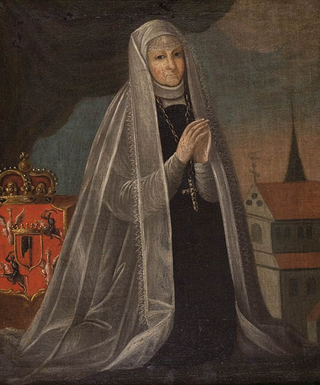
Elizabeth Granowska or Elisabeth Pilecki was Queen consort of Poland (1417–1420) as the third wife of Władysław II Jagiełło (Jogaila), Grand Duke of Lithuania and King of Poland.

Judith of Bohemia, also known as Judith Přemyslid, was a member of the Přemyslid dynasty and duchess of Poland by marriage. She was a daughter of Duke Vratislaus II of Bohemia and Adelaide of Hungary, and was married to Władysław Herman.
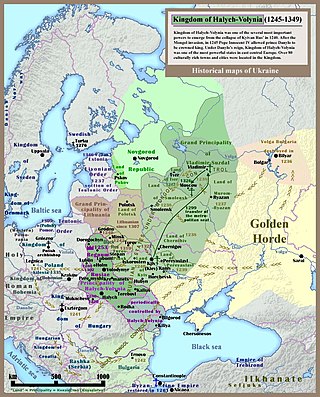
The Galicia–Volhynia Wars were several wars fought in the years 1340–1392 over the succession in the Kingdom of Galicia–Volhynia, also known as Ruthenia. After Yuri II Boleslav was poisoned by local Ruthenian nobles in 1340, both the Grand Duchy of Lithuania and the Kingdom of Poland advanced claims over the kingdom. After a prolonged conflict, Galicia–Volhynia was partitioned between Poland (Galicia) and Lithuania (Volhynia) and Ruthenia ceased to exist as an independent state. Poland acquired a territory of approximately 52,000 square kilometres (20,000 sq mi) with 200,000 inhabitants.

Nicholas I Garai was a most influential officeholder under King Louis I and Queen Mary of Hungary. He was ban of Macsó between 1359 and 1375, and palatine from 1375 until his death. He was also ispán or head of a number of counties over his lifetime.
The founding of Moldavia began with the arrival of a Vlach (Romanian) voivode, Dragoș, soon followed by his people from Maramureș, then a voivodeship, to the region of the Moldova River. Dragoș established a polity there as a vassal to the Kingdom of Hungary in the 1350s. The independence of the Principality of Moldavia was gained when Bogdan I, another Vlach voivode from Maramureș who had fallen out with the Hungarian king, crossed the Carpathians in 1359 and took control of Moldavia, wresting the region from Hungary. It remained a principality until 1859, when it united with Wallachia, initiating the development of the modern Romanian state.

Elżbieta Helena Sieniawska, née Lubomirska, was a Polish noblewoman, Grand Hetmaness of the Crown, and a renowned patron of the arts.
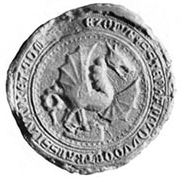
Stephen (I) Lackfi was an influential Hungarian nobleman and a successful military leader in the Kingdom of Hungary. He played a significant role in the Neapolitan campaigns of Louis the Great.















